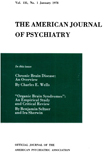ON ANOSOGNOSIA
Abstract
A 64-year-old male patient became totally blind following a cerebral vascular accident; there was no paralysis. He presented a Korsakow type of psychosis and a persistent anosognosia for his blindness. Despite the presence of optic atrophy it was assumed that the blindness was "essentially" of central origin. It was felt that the anosognosia as such was the result of the diffuse cortical disease and that a "functional" localization was more appropriate than a "topographic" one. It is also our opinion that this hypothesis applies particularly to cases of anosognosia for blindness and not to those who show anosognosia for a defect that involves the postural model of the body.
Access content
To read the fulltext, please use one of the options below to sign in or purchase access.- Personal login
- Institutional Login
- Sign in via OpenAthens
- Register for access
-
Please login/register if you wish to pair your device and check access availability.
Not a subscriber?
PsychiatryOnline subscription options offer access to the DSM-5 library, books, journals, CME, and patient resources. This all-in-one virtual library provides psychiatrists and mental health professionals with key resources for diagnosis, treatment, research, and professional development.
Need more help? PsychiatryOnline Customer Service may be reached by emailing [email protected] or by calling 800-368-5777 (in the U.S.) or 703-907-7322 (outside the U.S.).



